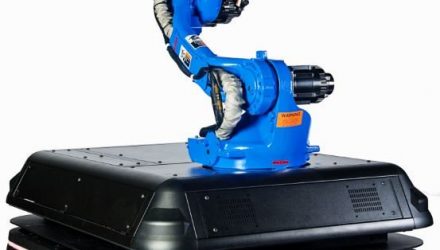However, if the robot consistently processes small batch sizes it is likely to move between tasks a lot. In this case, a mobile base might make sense for the same reasons as above.
3. Pick, transport and place
Pick and place is one of the most common tasks for cobots. As the name suggests, it involves picking up an object and placing it elsewhere in the robot’s workspace. A mobile cobot can be useful if the drop-off location is very far away from the pick-up location, e.g. when picking orders from a warehouse of shelves.
4. Very large workspaces
Large workspaces are the norm in the logistics sector. This sector is currently a huge driver for robotic adoption, as we discussed earlier this year. There are already several mobile cobots which are aimed at logistics applications. For example, the IAM Swift Solution was one of several mobile picking robots shown at this year’s MODEX 2018 in November.
If your robot needs to operate in large workspaces, added mobility can be a real help.
5. Completely automated workflow
Most cobot users want to combine their robotic tasks with manual tasks carried out by human workers. This is exactly what cobots are designed to do. However, you might want to convert a complete process to cobot automation.
To achieve a completely automated workflow, you would need to automate the transportation of objects between workstations. A mobile base is one way to do this, though not the only way.
How to assess your application for a mobile cobot
If a mobile cobot sounds like it might improve your situation, use the following 5 steps to gain a better understanding of the suitability of a mobile cobot in your workplace.
1. List how many tasks the robot could do
Mobility is most useful when the robot moves between several tasks. Start by listing all the tasks in your workspace which the robot could achieve.
Could a mobile base be used to move the robot between several of these tasks?
2. Assess each task for cobot suitability
Not all tasks are suitable for cobots. You will need to assess each potential task to find out if it can be achieved by a collaborative robot. We outline this process in detail in our eBook series Getting Started With Collaborative Robots, which we recently updated.
3. Assess the extended workspace
Adding a mobile base to your robot has the effect of increasing its workspace. Normally, a cobot’s workspace only contains its immediate surroundings. With a mobile cobot, the workspace stretches to the entire workfloor.
Roughly map out the whole area which the mobile cobot could reach. Notice any obstacles which may restrict its movement.
4. Monitor time it takes to switchover
One of the benefits of mobile collaborative robots is that they reduce the hands-on time required for changeovers between tasks.
Calculate the time that it currently takes to move the robot between tasks, including any time when the robot sits idle after it has finished its first task. This can be very easy to achieve using Robotiq Insights by looking at the robot’s utilization during the changeovers between tasks.
5. Consider other solutions
A mobile base is not the only solution. In fact, it may be overly complicated for your situation.
Before you invest in an expensive mobile robot, think of other potential solutions to your current problems.
For example:
- If your cobot is already close to capacity with one or two tasks, it may make more sense to invest in a second cobot.
- If you want the robot to travel so it can pick up objects from a shelf, there might be a simpler way to achieve this, e.g. move the robot cell closer to the shelf and reorder the objects.
- If you want to transport objects from one robot cell to another, a conveyor might be a viable option.
If you have assessed the other solutions and found that a mobile cobot really is the best solution, great! You can join the growing number of businesses who are already adding mobile collaborative robots to their processes.
For more investment strategies, visit ETF Trends.
